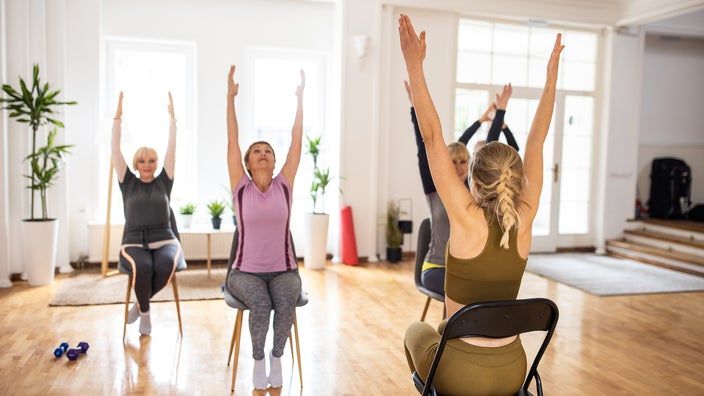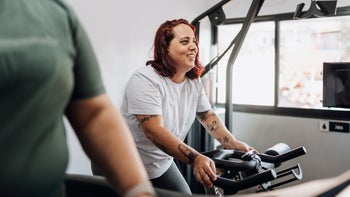
Why Chair Yoga Benefits People of Every Age and Body Type
Key takeaways:
Chair yoga allows you to perform yoga poses while seated or using a chair for balance.
Chair-based yoga offers the same benefits as traditional yoga, like boosting strength, flexibility, and mental well-being.
The practice is especially great for older adults, people with certain health conditions, and those who work at a desk all day.
Table of contents

From pain relief to better flexibility, the benefits of yoga are well documented. So it's no surprise that more than 90% of Americans who practice yoga do it for better health and wellness. But for some people –– including those with limited mobility or a chronic condition like arthritis or heart disease –– it may be difficult to practice traditional yoga.
For people who struggle with traditional yoga, chair yoga can be a great alternative. Learn what chair yoga is and how to practice it, including key poses to get you started, below.
What is chair yoga?
Chair yoga is a modified practice that involves doing poses while seated or using a chair for balance.
In 1982, yoga instructor Lakshmi Voelker-Binder developed chair yoga to provide an accessible option for a student with arthritis. Chair yoga includes the same elements as traditional yoga, including physical poses (asanas), meditation (dyana), and breathing techniques (pranayama). But the gentle practice modifies standard yoga poses so that you can do them while sitting in a chair or standing and using a chair for balance.
Most yoga poses –– such as twists, backbends, and forward folds –– can be adapted for chair yoga. So many studios offer chair yoga classes or traditional yoga classes that include seated modifications to fit a variety of abilities.
What are the best chair yoga poses for older adults? These seated postures are a great place to start.
Tai chi can improve balance, strength, and flexibility. Learn more about the benefits of tai chi and why it works for people of all fitness levels.
Sit at a desk all day? Try these stretches to break up long periods of inactivity and release muscle tension.
What are the benefits of chair yoga?
Chair yoga poses work many of the same muscles as traditional yoga poses. So the inclusive, modified practice provides similar health benefits.
Studies show that chair yoga may be beneficial for several health concerns. It’s also suitable for a range of age groups. For example, a small study found that it may improve functional mobility and well-being in older women.
Consider the following potential benefits of chair yoga.
Save over 40% on Qsymia with GoodRx
Discover the once daily Qsymia for weight management. Qsymia is for adults and children 12-17 in combination with a healthy diet and regular exercise.

Increased balance and flexibility
Maintaining balance and flexibility is critical for health and well-being. It can reduce your risk of injury and help you stay independent as you age. This is critical, as 3 million older adults go to the emergency room for fall-related injuries every year.
In a 2010 study, older adults in a retirement community practiced yoga twice a week for 12 weeks. They completed most poses while sitting in a chair or standing and using a chair for balance. At the end of the study, participants had better lower body flexibility and static balance. They also had less fear of falling and more confidence in their physical abilities.
Improved muscle tone and strength
According to studies, traditional yoga can improve strength in people of all ages. And a 2021 review found that chair yoga can help older adults develop and maintain muscle strength. The researchers conducting the review also found that chair-based exercise improves upper and lower body function. This is important because muscle mass declines with age. And that decline may be accompanied by a loss of strength and function in older adults.
Boosted mood and mental well-being
Practicing yoga may result in mental health benefits like less anxiety and a better mood. Evidence suggests that these benefits apply to many yoga styles, including chair yoga.
In a small-scale study, older adults took chair yoga classes once a week. After 3 months, they reported improvements such as less stress, better mood, and fewer panic attacks. They also saw a boost in their overall health, physical function, and social well-being.
Better management of chronic conditions
Seated yoga may help people manage chronic health conditions like Type 2 diabetes. For example, a small pilot study looked at the effects of a 10-minute chair yoga program in people with diabetes. Participants in the study received standard care, and a randomized control group was encouraged to incorporate the program into their daily lives. After 3 months, those in the control group showed improvements in their blood sugar, heart rate, and blood pressure.
Good to know: Chair yoga is not a replacement for traditional treatments for any health condition. Talk to a healthcare professional before starting any new exercise program, especially if you have any health conditions or current injuries.
Reduced chronic pain
Roughly 7% of adults experience chronic pain that affects their daily lives. Ongoing research shows that yoga may be an effective alternative to medication for chronic pain management. For example, according to one study, practicing chair yoga may help older adults reduce pain and fatigue from osteoarthritis.
Read more like this
Explore these related articles, suggested for readers like you.
What are the best chair yoga poses for beginners?
These five beginner-friendly poses can help you get started with your chair yoga practice. Just be sure to use a sturdy chair, and remember to listen to your body.
1. Chair forward fold
The chair forward fold pose helps stretch the lower back and legs. You can try seated forward fold variations or begin with the standard method, which is described below.
Step 1: Sit upright in a chair with your knees bent at a 90-degree angle and your arms straight down at your sides.
Step 2: Exhale, and slowly lean forward, moving your core toward your lap and your hands toward the floor.
Step 3: Rest your hands on the floor (or near the floor if they don't fully reach), and feel the stretch.
Step 4: Inhale and slowly raise yourself back to the starting position.
2. Chair cat-cow
Gentle and easy to do, the chair cat-cow pose helps improve flexibility in the spine. It may also reduce back, shoulder, and neck pain. As you advance, you can add cat-cow variations to your routine.
Step 1: Sit upright in a chair with your knees bent at a 90-degree angle and your hands on your knees.
Step 2: Inhale as you open your chest, move your shoulders back, and arch your back.
Step 3: Exhale as you bring your chin toward your chest, rounding your back and shoulders.
Step 4: Repeat 10 times in both directions.
3. Chair twist
The chair twist pose is great for lengthening your spine and enhancing flexibility. It may also help manage upper and lower back pain. And there are plenty of chair twist variations to try as you advance in your yoga practice.
Step 1: Sit upright in a chair with your knees bent at a 90-degree angle and your hands on your lap.
Step 2: Turn your upper body to the right, holding the back of the chair for support.
Step 3: Hold the position to feel the twist, and then repeat on the left side.
4. Chair pigeon
Like the traditional version, the chair pigeon pose can help manage pain and mobility issues related to hip arthritis. Pigeon pose variations allow you to increase or decrease the difficulty depending on your comfort level and abilities.
Step 1: Sit upright in a chair and bring your right leg over your left leg, so that your right ankle rests on your left thigh.
Step 2: Hold the position to feel the stretch in your right thigh, and then repeat on the left side.
5. Chair downward dog
If you have trouble with the standard version of downward dog, chair downward dog is a great alternative. It delivers the same stretching and strengthening benefits for your shoulders, lower back, and legs. And instead of sitting for this pose, you stand and use a chair for support.
As you get more comfortable with the move, you can try chair downward dog alternatives to increase the intensity.
Step 1: Stand upright with your arms at your sides, facing the seat of a chair.
Step 2: Slowly bend forward, and place your hands on the chair's seat.
Step 3: Hold the pose before returning to the starting position.
Who should do chair yoga?
Anyone can enjoy chair yoga. But the modified practice may be ideal for certain groups, including:
People 65 and older: Chair yoga for older adults is a safe, low-impact exercise that can promote healthy aging. The adaptability and benefits, such as a reduced risk of falls and better functional mobility, may make the practice particularly appealing to older adults.
People with chronic health conditions: Growing research indicates that a seated yoga practice can help people manage chronic diseases — and related pain — such as arthritis, diabetes, and dementia.
People with limited mobility: Seated yoga poses make the benefits of traditional yoga accessible to people with mobility concerns. For example, chair yoga has been shown to help people with multiple sclerosis and those recovering from spinal cord injuries.
People who work in an office: Sitting at a desk for prolonged periods can cause exhaustion, high blood pressure, and pain in the lower back, neck, and shoulders. Practicing yoga in the workplace may help relieve back pain and boost mental well-being. One study found that just 15 minutes of chair yoga in the office can improve physical and psychological stress.
Still, it's best to talk to a healthcare professional before starting chair yoga, especially if you have any health concerns or conditions.
How often should you practice chair yoga?
There is no official guideline on how often you should practice chair yoga. However, the CDC recommends that adults 65 and older get 2 days of strengthening exercises and 3 days of balance activities every week. And practicing chair yoga two to three times a week can be a good place to start.
Remember that some amount of exercise is better than none. In fact, research shows that even infrequent yoga sessions may benefit older adults.
The bottom line
Chair yoga is a modified version of traditional yoga that offers similar physical and mental health benefits. The mostly seated practice can be an excellent option for people of all ages and abilities. But it's especially well-suited for older adults, people with mobility issues, and those who sit at a desk for extended periods.
Why trust our experts?



References
Centers for Disease Control and Prevention. (2023). Physical activity for older adults: An overview.
Centers for Disease Control and Prevention. (2024). Facts about falls.
Curtis, K., et al. (2017). Evaluation of a specialized yoga program for persons with a spinal cord injury: A pilot randomized controlled trial. Journal of Pain Research.
Daneshmandi, H., et al. (2017). Adverse effects of prolonged sitting behavior on the general health of office workers. Journal of Lifestyle Medicine.
Galantino, M. L., et al. (2012). Safety and feasibility of modified chair-yoga on functional outcome among elderly at risk for falls. International Journal of Yoga.
Gilberston, R. M., et al. (2017). Mindfulness in motion for people with multiple sclerosis: A feasibility study. International Journal of MS Care.
Hartfiel, N., et al. (2012). Yoga for reducing perceived stress and back pain at work. Occupational Medicine.
Klempel, N., et al. (2021). The effect of chair-based exercise on physical function in older adults: A systematic review and meta-analysis. International Journal of Environmental Research and Public Health.
Lin, Y. C., et al. (2017). Using integrative medicine in pain management: An evaluation of current evidence. Anesthesia & Analgesia.
Melville, G. W., et al. (2012). Fifteen minutes of chair-based yoga postures or guided meditation performed in the office can elicit a relaxation response. Evidence-Based Complementary and Alternative Medicine.
Mullur, R. S., et al. (2016). Impact of a 10 minute seated yoga practice in the management of diabetes. Journal of Yoga & Physical Therapy.
National Center for Complementary and Integrative Health. (2023). Yoga: What you need to know.
National Institute on Aging. (2022). What do we know about healthy aging?
Park, J., et al. (2017). A pilot randomized controlled trial of the effects of chair yoga on pain and physical function among community-dwelling older adults with lower extremity osteoarthritis. Journal of the American Geriatrics Society.
Park, J., et al. (2019). Feasibility of conducting nonpharmacological interventions to manage dementia symptoms in community-dwelling older adults: A cluster randomized controlled trial. American Journal of Alzheimer's Disease & Other Dementias.
Ross, A., et al. (2012). Frequency of yoga practice predicts health: Results of a national survey of yoga practitioners. Evidence-Based Complementary and Alternative Medicine.
Schmid, A. A., et al. (2010). Effect of a 12-week yoga intervention on fear of falling and balance in older adults: A pilot study. Archives of Physical Medicine and Rehabilitation.
Sherrington, C., et al. (2020). Evidence on physical activity and falls prevention for people aged 65+ years: Systematic review to inform the WHO guidelines on physical activity and sedentary behaviour. International Journal of Behavioral Nutrition and Physical Activity.
Streeter, C. C., et al. (2010). Effects of yoga versus walking on mood, anxiety, and brain GABA levels: A randomized controlled MRS study. Journal of Alternative and Complementary Medicine.
Stussman, B. J., et al. (2015). Wellness-related use of common complementary health approaches among adults: United States, 2012. National Center for Complementary and Integrative Health.
Tew, G. A., et al. (2017). Adapted yoga to improve physical function and health-related quality of life in physically-inactive older adults: A randomised controlled pilot trial. BMC Geriatrics.
Tummee. (n.d.). Adho mukha svanasana variation chair.
Tummee. (n.d.). Adho mukha svanasana variation chair: Variations.
Tummee. (n.d.). Chair cat cow pose.
Tummee. (n.d.). Chair cat cow pose: Variations.
Tummee. (n.d.). Chair pigeon pose.
Tummee. (n.d.). Chair pigeon pose: Variations.
Tummee. (n.d.). Chair seated twists.
Tummee. (n.d.). Chair seated twists: Variations.
Tummee. (n.d.). Seated forward fold pose on chair.
Tummee. (n.d.). Seated forward fold pose on chair: Variations.
Volpi, E., et al. (2004). Muscle tissue changes with aging. Current Opinion in Clinical Nutrition & Metabolic Care.
Wang, F., et al. (2020). Effects of yoga on stress among healthy adults: A systematic review. Alternative Therapies in Health and Medicine.
Yao, C., et al. (2019). Effectiveness of chair yoga for improving the functional fitness and well-being of female community-dwelling older adults with low physical activities. Topics in Geriatric Rehabilitation.
Zelaya, C. E., et al. (2020). Chronic pain and high-impact chronic pain among U.S. adults, 2019. NCHS Data Brief.



























